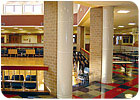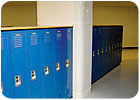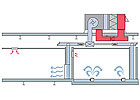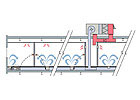
Figure 1. Blue
Valley’s North Valley High School, which had been experiencing IAQ problems,
was the first school in the district to be retrofitted with displacement
ventilation.

Figure 2. North
Valley High School went from having a fan-powered terminal unit system with hot
water heat to a VAV displacement system with hot water heat.
When officials in the Blue Valley School District (BVSD) in Overland Park, KS started taking a hard look at the 35 buildings in their care, they knew some changes had to be made. Many of the schools were built during the energy crises of the 1970s and early 1980s, when recommended ventilation rates were around 7 cfm/person. Today ASHRAE recommends 15 cfm/person, so many of the Blue Valley schools were under-ventilated. BVSD officials took the unusual step of looking forward and backward in how it would address the ventilation issues in its schools. Going forward, it was decided that the new schools would use a combination of underfloor air distribution (UFAD) and displacement ventilation (DV) systems, while existing schools would be systematically upgraded with DV systems. The goal in both cases was improving IAQ and reducing energy costs.

Figure 3. The
change in IAQ at North Valley High School has been dramatic. Before the DV
system was installed, there were numerous complaints, but after the renovation,
there have been almost no complaints.
Trying Something New
The engineering firm of Larson Binkley, Inc. (Overland Park, KS) has designed most of the heating and cooling systems in the BVSD since 1987. The primary design for elementary schools involved water source heat pumps (WSHP) and an overhead, dual-duct VAV system. When working on a prototype elementary school in the late 1990s, vice president Jim Megerson, P.E., decided he wanted to try something different.“The school was originally designed with an overhead ducted system, but I was frustrated, because every time we turned around, we had to move data or electrical outlets,” said Megerson. “I was thinking that life had to be easier than this. I started talking to the district about putting in raised access floors, so there would be access to the building’s infrastructure, not to mention the added benefits of enhanced IAQ and potential energy savings.” Larson Binkley had designed numerous UFAD systems for commercial applications and Megerson was convinced they would work just as well in a school setting. BVSD officials were a little skeptical at first and had numerous questions about energy savings and how the technology would improve IAQ. One of their more interesting concerns involved what would happen if a child vomited into one of the floor diffusers.
Megerson dealt with this concern on a site visit with BVSD officials. “We concocted a mixture of oatmeal, raisins, and Cheerios, and when the district representatives asked what would happen, we tossed it into the diffuser. Then we picked up the phone, called maintenance, and told them about the ‘accident’ with the diffuser.”
In about 15 min, a maintenance man was able to remove the carpet and swap out the existing diffuser with a new one without interrupting anybody’s work. BVSD officials were satisfied and authorized Megerson to re-design the prototype elementary school with a UFAD system in the classrooms. DV systems were also specified in the prototype school, to be used in areas in which it didn’t make sense to put a raised access floor, such as the gymnasium, kitchen, cafeteria, and multipurpose rooms. The resulting Liberty View Elementary School opened for the 2002 school year.

Figure 4. Liberty
View Elementary uses a UFAD system in the classrooms, while DV systems are used
in the gymnasium, kitchen, cafeteria, and multipurpose rooms.
IAQ Issues Arise
IAQ Issues Arise At about the same time Liberty View was being redesigned, other problems concerning IAQ began cropping up in the district. “We had buildings that were limping along, and it wasn’t a good situation. Most of the problems could be attributed to under-ventilation,” said Monte Soukup, director, design and construction, BVSD. “In addition, many of the schools’ systems were reaching 20 to 25 years of age, and there were associated maintenance issues.”It was far too expensive to retrofit the troubled schools with UFAD systems, but using DV made perfect sense. “For the past four years, we have removed underperforming systems and replaced them with displacement ventilation and upgraded lighting systems. It amounts to between $2.5 and $3 million in construction that has to be completed in about two and a half months,” said Megerson. “Our success rate has been very good with these retrofitted schools, and we’ve reduced the energy consumption as much as 17%.”
Blue Valley’s North Valley High School, which had been experiencing IAQ problems, was the first school in the district to be retrofitted with DV. The school went from having a fan-powered terminal unit system with hot water heat to a VAV displacement system with hot water heat. Displacement diffusers designed to distribute 65°F air at 50 fpm were placed near the floor, while return air registers located in or near the ceiling allow the air to return through the plenum to the rooftop unit.
The change in IAQ has been dramatic, according to Soukup. “We had a tremendous number of complaints at the high school prior to the renovation. Once we changed to a displacement system, we had almost no complaints.”
The success of the new ventilation systems at Liberty View Elementary and North Valley High School started the ball rolling. Subsequently, two new elementary schools were constructed using UFAD and DV systems, and three existing schools received DV systems over a phased retrofit schedule. There are still five schools left to be upgraded in the district’s current bond.
Rather than using WSHP, it was decided that the new elementary schools would utilize air cooled chillers and electric boilers. “The district decided to upgrade its base heating and cooling systems on the three new schools that were going to utilize UFAD,” said Megerson. “Our electricity rates are very low and natural gas prices have become more volatile in our market, so it makes sense for the schools to be all electric.”
Schools undergoing major mechanical renovations are often upgraded to chillers and boilers as well. Megerson noted that the savings from replacing heat pump systems in the district with chillers, boilers, and DV have resulted in a 15% energy savings on a repeated basis, as well as reduced maintenance and improved IAQ. Also contributing to the energy savings are new lighting, CO2sensors, and demand controlled ventilation strategies, which are utilized on each remodel.
Some schools that have been remodeled experience an even greater energy savings. Soukup points to Overland Trail Middle School, which was changed over from a heat pump overhead mixing system to a chiller system utilizing DV air distribution. “An evaluation of the energy consumption was done on that school, and we saw close to a 30% savings. With the heat pumps, we could only deliver about half of the outdoor air we needed, but now we’re delivering more fresh air where it’s needed at a lower cost. It’s a win-win,” he said.

Figure 5. After
Liberty View Elementary was built, it was decided that new schools would use a
combination of UFAD and DV systems.
No Ordinary Design
Even though UFAD and DV systems operate under similar principles, they are very different from one another (sidebar). And they are very different from conventional systems, so certain factors need to be taken into consideration when designing either system.“It’s very difficult for engineers to be successful on the first UFAD system they design,” said Megerson. “The equations we use to calculate loads aren’t 100% transferable to an underfloor air system. That’s because with UFAD you’re stratifying the load in the space, so the way the load is distributed in the building is much different than with a conventional overhead system.”
Designing a UFAD system also requires the help of other trades to ensure there is a minimal amount of leakage. The architect usually figures out how the raised access floor will be laid out in the building, and the general contractor needs to be aware of the importance of sealing the airway underneath the floor. Improper sealing can lead to leakage issues, and as Megerson noted, there’s good leakage and bad leakage. The issue is determining what kind of leakage is occurring.
“Is the leakage going into the space? Is it going outside the space? You have to watch for that,” said Megerson. “Leakage into the space is not necessarily bad, as long as you know how much it is. We plan for a certain amount of leakage to go into the space, then we make that adjustment when determining the number and placement of diffusers. Bad leakage is when it goes into the wall cavity or the return.”
The other situation to watch for is when the raised access floor is energized with air. This is where the architect plays a crucial role, because typically there is a need to reduce the number of shafts in the building, and that can sometimes compromise the UFAD system. “Our rule is that the furthest diffuser on the perimeter should not be more than 50 feet from where you inject air into the raised floor plenum,” said Megerson.
That number may be exceeded slightly on the ground level, because the ground itself is insulating. These rules exist because air in the plenum can gain heat from a number of places, including the floor, the floor below (on a multi-story building), the ceiling, the slab, and the exterior. The result is that as the 60° air travels through that raised access floor, it becomes warmer, so that by the time it reaches the perimeter it can be several degrees warmer. That needs to be figured into the design.
Of course, Megerson added, “This is only a rule of thumb and there are always circumstances that can affect the rule. Every scenario must be evaluated properly and appropriate adjustments must be made. Other factors that can affect these distances are raised access floor height, amount of cabling infrastructure and other architectural features that can create impediments to airflow.”
There is less of a learning curve where DV is concerned, because it is still a more traditional ducted system. The load calculations are different than what would be used when designing a traditional overhead system, but ductwork is going to each diffuser, so it’s more familiar. Basically, everything above the ceiling is more conventional; the difference is below the ceiling.
“With displacement ventilation, there’s a misconception that you effectively dehumidify utilizing 60° or 65° air,” said Megerson. “What we do is still bring the supply air temperature to 55° or 58° and use return air bypass around the cooling coil, using it as free reheat on the supply side. If you do your adiabatic mixing formulas, it doesn’t take much air to accomplish the amount of reheat that you need to get the air back to 60° or 65°. Not to mention reheat from the motor, which could be 2° to 3°.”

Figure 6. DV
systems supply slightly cool air at low velocities directly to the occupied
zone from outlets at or near the floor level.
Lessons Learned
Having designed many new schools and major mechanical remodels in the BVSD, Megerson has learned some lessons along the way. One of those lessons involved the first elementary schools he designed utilizing UFAD systems. “I think our earlier jobs were over-designed, because we were conservative. Many of those jobs are 1.1 cfm/sq ft, where now many of our jobs are less than 1 cfm/sq ft. We’ve gotten better at figuring out the load, and we’re more comfortable with the system.”Soukup added that the chiller sizing and number of VAV boxes has changed over time as well. “Now we use multiple small chillers and stage them, in order to eke out more energy savings. And on the first school, we had 11 diffusers in each classroom, and by the time we built the third one, we were down to six. The designs have really been wrenched down and tightened up to make them more efficient.”
Another revelation Megerson had is that perhaps elementary classrooms don’t need the flexibility a UFAD system affords. Therefore, future schools in BVSD will use DV in the classrooms and UFAD in administration and library areas, where wires, cables, and flexibility are more of an issue. DV offers the same IAQ benefits as UFAD, and similar energy savings as well.
“According to ASHRAE, displacement ventilation has a ventilation effectiveness of 1.2, which means that it’s 20% more effective at getting outdoor air down in the occupied zone for the occupant. With an overhead mixing cooling-only system, it’s 1.0, and with a heating system it’s 0.8. There are no numbers for underfloor air on ventilation effectiveness yet,” said Megerson.
What he does know, though, is that CO2levels in schools containing both DV and UFAD systems are very similar. When the outdoor air measures 550 ppm of CO2, BSVD classrooms with DV or UFAD run between 600 to 650 ppm. “We get the same IAQ benefit whether it’s DV or UFAD,” said Megerson. “We don’t get quite the same energy savings benefit, but it’s close.”
When compared to an overhead ducted VAV system, a UFAD system is usually 24% to 29% more energy efficient. The large energy savings is due to the fact that the air pressure in an UFAD system is much lower than that in an overhead ducted system, so the fans can be 40% to 50% smaller. Since fans account for a majority of the energy usage in a building, there is quite a bit of savings associated with the smaller fans. A DV system usually results in approximately 17% energy savings compared to overhead mixing systems.
“With displacement ventilation alone, we will get the same IAQ benefits from an air distribution standpoint and not have to pay for the access floor,” said Soukup. New high schools in BVSD may utilize UFAD systems in the classrooms and DV everywhere else, but that has yet to be determined.
BVSD personnel are all very happy with the improved IAQ and energy savings associated with the DV and UFAD systems installed around the district. While UFAD systems aren’t ideal for a retrofit situation, Soukup said he would encourage anyone looking at system replacement to consider DV.
“The improved air quality is noticeable. It’s dramatically better. And there’s about a 20% savings in energy costs. From a first-cost standpoint, it’s cheaper than a dual duct VAV system and comparable in cost to a single duct VAV system. Why would you want to do anything else?”

Figure 7. UFAD
systems supply air through a raised floor to local areas typically near
building occupants and return air at or near the ceiling.
Side Bar: Different But Similar
To avoid confusion, it is necessary to understand the differences between a displacement ventilation (DV) system and an underfloor air distribution (UFAD) system. A recent report issued by the National Institute of Standards and Technology (NIST)1provides the best explanation of the differing systems:The 2001 ASHRAE Handbook - Fundamentals (HOF) classifies room air diffusion systems as mixing, displacement, unidirectional, and underfloor. The HOF describes mixing systems as normally discharging conditioned air from outlets near either the ceiling or floor at velocities much greater than those acceptable in the occupied zone to achieve a level of air mixing that creates relatively uniform air velocity, temperature, humidity, and air quality conditions in the occupied zone. Most non-industrial buildings in the U.S. use mixing systems.
In contrast, the HOF describes DV systems as supplying slightly cool air at low velocities directly to the occupied zone from outlets at or near the floor level. The supply air spreads over the floor, forms thermal plumes upon encountering heat sources, and is exhausted by system returns located at or near the ceiling. DV systems purposefully minimize mixing and, in fact, are designed to establish a stable thermal stratification level above the occupied zone such that no mixing occurs between the upper and lower zones.
UFAD systems supply air through a raised floor to local areas typically near building occupants and return air at or near the ceiling. Since both UFAD and DV systems utilize a similar low supply paired with high return pattern, the two are often confused. However, UFAD systems differ from DV systems because they typically supply air at higher velocities such that their higher supply volumes are able to meet larger cooling loads. Depending on the design details of the system and space, UFAD systems may operate as DV systems.

